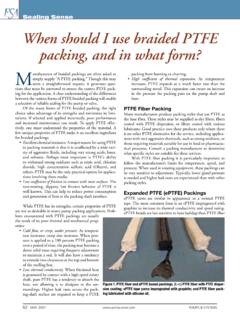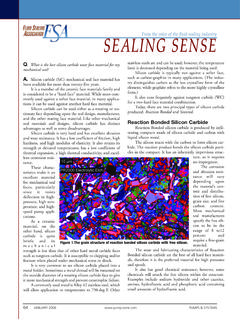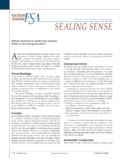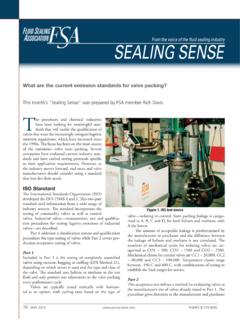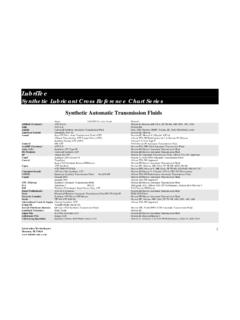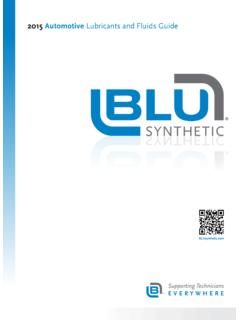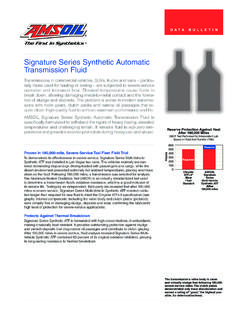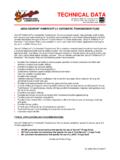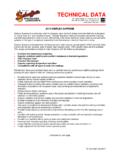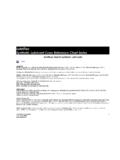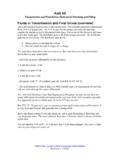Transcription of Buffer & Barrier Fluids - | Fluid Sealing Association
1 Sealing SENSE. Buffer & Barrier Fluids What are the differences between using water or oil as a Buffer or Barrier Fluid ? By FSA member Mark Savage A s operators of pumping equipment become more focused on the safety, reliability and environmental impact resulting from shaft seal leakage, dual mechanical the atmosphere, liquid Buffer and Barrier Fluids lubricate the mechanical seal and transport frictional heat and absorbed heat from the mechanical seal to a heat exchanger. This con- seals have become more prevalent in the industry. A dual trols the Fluid 's temperature and lubricating properties. mechanical seal offers a second (outer) seal to contain the pumped Fluid by creating a cavity or chamber between the Buffer & Barrier Fluid Supply inner and outer seal that can be filled with a Fluid .
2 When this Buffer / Barrier Fluid can be stored, monitored and delivered Fluid is unpressurized, it forms a Buffer between the pumped using many methods. Each is identified by a piping plan Fluid and atmosphere and is commonly referred to as a number that describes the minimum requirements of each Buffer Fluid . When pressurized, it forms a Barrier between system. The most commonly referenced piping plan origi- the pumped Fluid and atmosphere and is known as a Barrier nates from the American Petroleum Institute's standard API. Fluid . 682. Although mechanical seal designs are available in con- figurations that use either a liquid or a gas as a Barrier Fluid , Unpressurized Systems the following discussion focuses on liquid Buffer and Barrier A Plan 52 system (see Figure 1) provides a reservoir that Fluids only.
3 In addition to separating the pumped Fluid from stores the Buffer Fluid . Supply and return lines are connected Figure 1. Simplified schematic of a Plan 52 system Figure 2. Simplified schematic of a Plan 53A system 104 October 2013 Pumps & Systems to the mechanical seal and circulation of the Buffer Fluid is pumps pressurize and circulate the Fluid . In open-loop achieved by an internal circulating device (pumping ring) systems, a compatible process stream is used as the within the mechanical seal. The vapor space above the Buffer Barrier Fluid and is circulated through the mechanical Fluid in the reservoir is vented to atmospheric pressure typi- seal and returned to another point downstream in the cally via a flare or vapor recovery system.
4 The reservoir can be process. instrumented to measure the liquid level and pressure in the reservoir. Ports are fitted to the reservoir to facilitate mainte- Important Characteristics of a nance activities such as inspection and cleaning or refilling Buffer / Barrier Fluid and draining the Buffer Fluid . Cooling is accomplished using Several critical properties of a Buffer or Barrier Fluid must be an internal heat exchanger. considered when making a selection. An ideal Buffer or bar- rier Fluid will have the following properties: Pressurized Systems Safe to use, handle and store Pressurized dual seal systems contain the same essential com- Compatible with seal materials ponents as an unpressurized system. However, they also con- Not a volatile organic compound, volatile hazardous tain a way to pressurize the Barrier Fluid .
5 The following plans air pollutant or other regulated compound may be used for pressurized dual seal systems: Good flow qualities at operational temperatures Plan 53A A pressurized gas blanket in the reservoir (including very low temperature service). pressurizes the Fluid . Nitrogen is normally used and Nonflammable the pressure is controlled via a pressure regulator (see A stable liquid at ambient temperatures Figure 2). The Barrier Fluid is in direct contact with the Family Fluid Name Viscosity Pour Boiling Specific Heat Thermal Pump Temperature Point Point Conductivity Range pressurized gas. @ 15 C 40 C 100 C @ 15 C (60 F) @ 15 C (60 F) Min Max Plan 53B Pressure is (60 F) (104 F) (212 F). cSt cSt C. ( F). C. ( F). kJ/kg K W/m K.
6 (BTU/lb F) (BTU/hr ft F). C. ( F). C. ( F). generated as a nitrogen-filled 0 100 5 70. Water 1 bladder is compressed by the Water and glycol (32) (212) ( ) ( ) (40) (160). addition of Barrier Fluid into solutions Propylene -33 106 -29 77. Glycol (-28) (222) ( ) ( ) (-20) (170). the bladder accumulator. n-Propyl- -126 97 -124 69. The bladder prevents direct Alcohols Alcohol (-195) (207) ( ) ( ) (-191) (157). contact of the pressurized gas -29 149 -23 121. K-1 Kerosene 1. with the Barrier Fluid . (-20) (300) ( ) ( ) (-10) (250). Plan 53C A pressure Kerosene K-2 Kerosene -34 177 -29 132. (-30) (350) ( ) ( ) (-20) (270). amplifying piston uses pres- and diesel -34 177 -29 149. sure from within the pump fuels D-1 Diesel (-30) (350) ( ) ( ) (-20) (300).
7 (typically the seal chamber) -59 182 -12 82. D-2 Diesel to amplify the Barrier pressure (-75) (360) ( ) ( ) (10) (180). by the ratio of the area on Lube-1 -59 104 ~ ~ -29 76. (-75) (219) (~ ) (~ ) (-20) (169). each side of the piston. The -12 168 ~ ~ -7 140. Barrier Fluid is not exposed to Lube oils Lube-2 (10) (335) (~ ) (~ ) (20) (285). any pressurized gas. -50 >149 ~ ~ -7 135. Lube-3 Plan 54 An external system (-58) (>300) (~ ) (~ ) (20) (275). -62 371 -32 221. is used to pressurize and Synth-1 7 (-80) (700) ( ) ( ) (-25) (430). circulate the Barrier Fluid . Synthetic 62 371 -4 227. A Plan 54 system can be lube oils Synth-2 22 (-80) (700) ( ) ( ) (25) (440). broadly classified into two Synth-3 -50 256 17 227. (-58) (493) ( ) ( ) (62) (440).
8 Groups: closed- and open- Heat transfer -4 343 13 316. loop systems. In closed-loop Fluids Aromatic-1 29 4. (25) (650) ( ) ( ) (55) (600). systems, the Barrier Fluid is stored in a large reservoir and Table 1. Typical Buffer and Barrier Fluid properties PUMPS & SYSTEMS October 2013 105. Sealing SENSE. Good lubricity Water Non-foaming when pressurized Water offers several benefits as a Buffer / Barrier Fluid . Its Good heat transfer properties thermal conductivity is about three times greater than oils Low gas solubility and its specific heat is about twice that of oils, so it is good Compatible with process Fluid at transporting heat away from a mechanical seal. Water is Inexpensive inexpensive, easy to handle and store, has few seal material compatibility issues and is nonflammable.
9 It is also compat- Buffer / Barrier Fluid Families ible with many aqueous pumped solutions. Its viscosity is Liquids that have characteristics suitable for use as Buffer and generally around 1 centistoke at moderate temperatures Barrier Fluids can be broadly classified into the following: which offers low resistance to flow in the Barrier system. Water and glycol solutions However, the viscosity becomes low at elevated tempera- Petroleum-based hydraulic and lubricating oils tures limiting its effectiveness as a lubricant for the mechan- Alcohols ical seal faces. Water is also susceptible to freezing during the Synthetic hydraulic oils winter months. This results in a narrow window of service Kerosene and diesel fuels and environment temperatures in which water can be used.
10 Heat transfer Fluids Oils Typical physical properties of Fluids in these categories are Generally, oils can be used in a much wider range of service listed in Table 1 with a suggested service temperature range. temperatures. Compared to water, oils offer greater Fluid stability at elevated temperatures and are not susceptible to freezing. They also provide excellent lubrication of the Do you need PDH Credit? Visit today U N M AT C H A B L E E X P E R I E N C E. I N P R I VAT E C O M PA N Y. Pump Systems Matter is the pump industry's TRANSACTIONS educational resource for pumps, pump accessories and pump systems efficiency. Offerings include: Jordan, Knauff & Company is a knowledgeable and experienced provider of a comprehensive line of investment banking services to the pump, valve and t -JWF 5 FDIOJDBM 8 FCJOBST.
